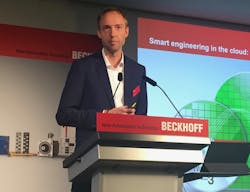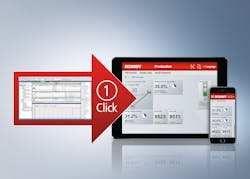In Beckhoff’s first TwinCAT-related announcement at this year’s SPS, the company introduced TwinCAT Cloud Engineering—a means of engineering TwinCAT instances and controllers in the cloud. According to Beckhoff, with TwinCAT Cloud Engineering, users can instantiate and use existing TwinCAT engineering and runtime products directly in the cloud with no additional software required. TwinCAT Cloud Engineering instances generated by users can be connected to physical control hardware over a secure transport channel. Beckhoff says this new offering can work with previously unsupported devices, such as tablet PCs.
TwinCAT Cloud Engineering also allows users to move their entire TwinCAT architecture to the cloud. Beckhoff says that, in doing so, the only difference versus a conventional TwinCAT environment is that engineers will use a virtual machine instead of a local engineering PC. Another advantage to TwinCAT Cloud Engineering is that users do not have to install and maintain multiple software versions tailored to specific machine generations on their own PCs. Instead, users can run separate TwinCAT Cloud Engineering instances with different software versions, all of which can be accessed remotely. Project files are stored in a source code control repository which can be accessed directly from within TwinCAT Engineering.
The second TwinCAT-related announcement at SPS was the One-Click Dashboard. Supported by TwinCAT Analytics’ ability to convert analysis configurations into executable PLC code, the One-Click Dashboard is designed to reduce the time-consuming process of HMI dashboard creation.
According to Beckhoff, with One-Click Dashboard, only one mouse click is required to generate an entire HTML5-based analytics dashboard based on the application’s PLC code and load it into a selected Analytics Runtime container. When the process completes, users receive a network address they can use to access the dashboard in a web browser. No code writing or graphic design is required.
Though the dashboards are automatically generated, they can be customized by configuring individual user settings. For instance, users are able to pick their own header colors and logos; users can also choose to show geographically distributed machine locations on a world map. Dashboard images are available in a choice of layouts and themes as well as multiple languages.
Further modifications to the dashboards can also be made in Visual Studio for adaptation in the graphical editor. Beckhoff noted that, even with dashboards that need extensive customization, the engineering process with this approach still involves far fewer clicks than the conventional approach.
Earlier in 2019, Beckhoff added machine learning to TwinCAT. See the video about this from Hannover Messe 2019.
Leaders relevant to this article:




